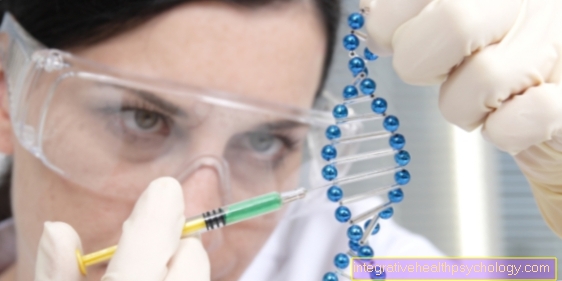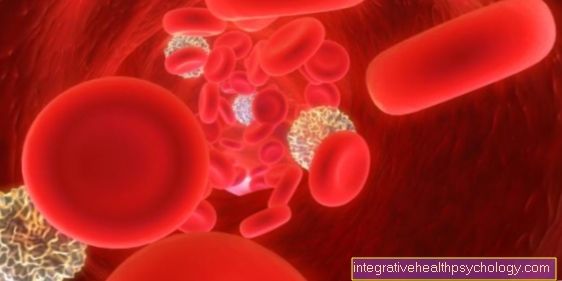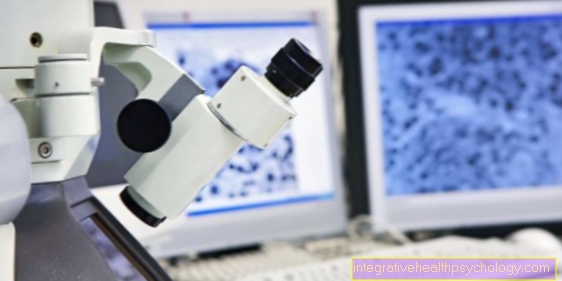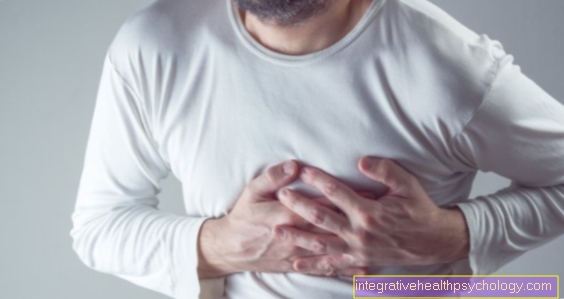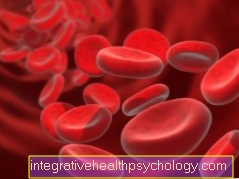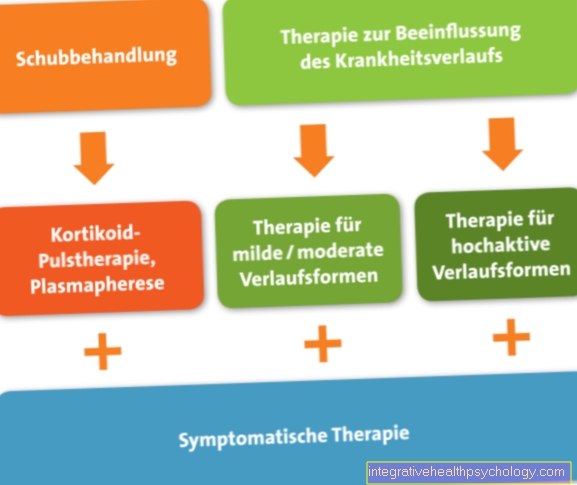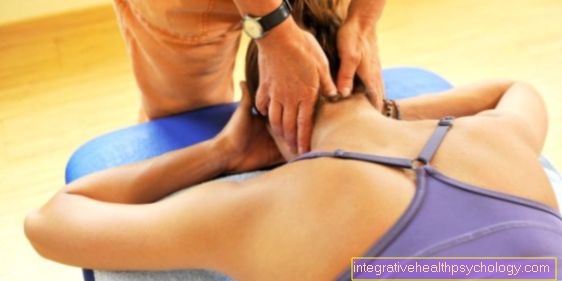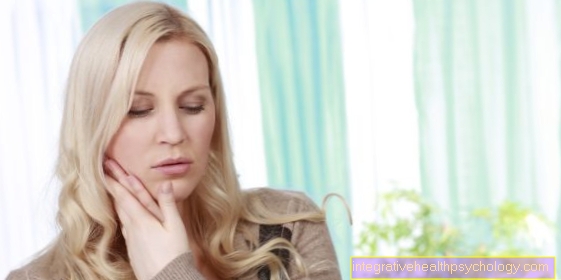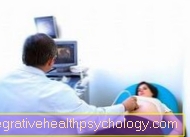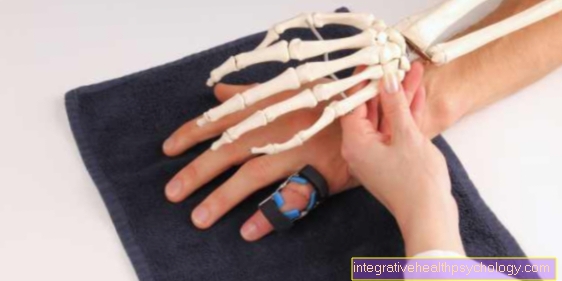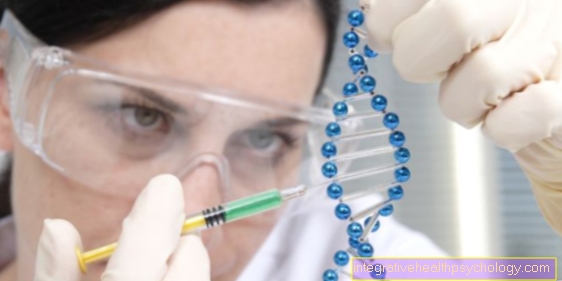Signs of a stroke
General
A stroke is a serious condition that affects the brain. There is either bleeding in the brain or an insufficient supply due to a blocked blood vessel. As a result, parts of the brain are no longer adequately supplied with blood and, depending on the location of the damage, typical symptoms occur. The signs of a stroke thus vary depending on the location of the affected brain region.
Read more on the subject at: Symptoms of a stroke

Correctly interpreting symptoms as signs of a stroke is essential, as treating a stroke early can save valuable brain tissue. If a stroke is suspected, an emergency doctor should be called as soon as possible. A quick supply in a clinic with a so-called "Stroke Unit“Can help save brain tissue and relieve the signs of a stroke. The signs of a stroke can regress over the course of stroke treatment, but they can persist for life.
Typical signs
Depending on the affected brain region, typical symptoms of a stroke can arise. The symptoms begin when the affected cells in the brain no longer have sufficient oxygen available. It is typical here that the symptoms only appear on one side and on the arm or leg and on the face.
Read the following article: Stroke Symptom Test - I can test this myself
Paralysis and loss of strength in individual body regions often occur. In the face, paralysis of individual muscles (see: muscle weakness, foot dorsiflexion paresis) can typically be noticed by one-sided hanging corners of the mouth.
Drooping eyelids or the inability to frown are also common. Furthermore, visual disturbances and even blindness (see: Blindness due to stroke) are common symptoms of a stroke. If certain muscles that are responsible for normal speech control are affected by the stroke, it can lead to blurred, indistinct or even total loss of speech.
Sudden attacks of dizziness and disturbances of balance should be understood as a possible expression of an acute stroke. Those affected can suddenly no longer keep their balance while walking or sitting. Understanding problems and an inability to express oneself correctly are also possible signs of an acute stroke.
Also read our articles:
- Dizziness after a stroke
- Dizziness with imbalance
- Dizziness and blurred vision
If a cerebral hemorrhage is responsible for the lack of oxygen supply in the brain, very severe and sudden headaches are another sign of the disease. Total loss of consciousness can also be a symptom of a stroke (see: Cerebral Hemorrhage Symptoms).
If one or more of these symptoms occur, medical advice should always be sought as soon as possible. A suspected stroke is an emergency and should therefore be clarified without wasting time.
You may also be interested in this topic: These symptoms will help you recognize a blood clot in your head
If there are typical symptoms of a stroke, it is important to confirm or rule out this suspicion as soon as possible. Read more about this at: This is how a stroke is diagnosed
Signs in the eyes
The eyes are a common localization of the first signs of a stroke. Visual disturbances occur particularly frequently, which manifest themselves in the form of double vision, blurred "spots" or a total loss of the affected eye.
Learn more about that Scotoma.
Unlike most of the other signs of a stroke, both sides are often affected by the failures. This means that only half of the field of vision can be impaired on both sides.
In addition to impaired vision, a stroke can also lead to a drooping eyelid on one side.
Read more on the subject at:
- Eye muscle paralysis
- Stroke blindness
- Stroke in the eye
Signs of a cerebellar infarction
In the case of a cerebellar infarction or stroke of the cerebellum, various symptoms can occur that are characteristic of a functional failure in this area of the brain. Thus, many cerebellar infarctions can be differentiated from strokes in the cerebrum. Since the cerebellum plays a decisive role in many movement processes, deficits arise there, above all. In addition, fine motor skills, speech and articulation in general can be disturbed.
Read more about this under: Cerebellar infarction
If there are typical symptoms of a stroke, it is important to confirm or rule out this suspicion as soon as possible.Read more about this at: This is how a stroke is diagnosed
Tingling as a sign
Abnormal sensations are often perceived as tingling on the skin and can be a sign of a stroke. Particularly when tingling of the skin and numbness occur together, the possibility of an acute stroke should be considered. It is also noticeable if the tingling occurs only on one side and on the arm or leg.
In general, however, the tingling sensation alone can only be attributed to a stroke in rare cases. Damage to the nerves in the arms or legs or the neck is often responsible for the tingling sensation. However, if the abnormal sensations are accompanied by paralysis or abnormalities in the face, as well as speech and vision, an emergency doctor should definitely be called as a stroke is a likely diagnosis.
Any numbness should be seen as a warning sign that can indicate an undersupply of the tissue. Find out more about this topic at: Numbness of the tongue
Signs in the man
Stroke can occur in both men and women. In general, the signs in men and women are relatively similar. Differences are typically caused by the affected brain region and not by gender. In men, however, the "typical signs" are more likely to occurthan with women.
Classically should sudden onset of paralysis and Loss of strength on the arm and leg as well as on the face are examined as signs of a stroke. Also at Speech and vision disorders for no apparent cause, as well Balance disorders and the Inability to express yourself correctly these are typical signs of a stroke.
Signs in the woman

The classic signs A stroke also occurs in women and should therefore be perceived as such regardless of gender. Here are especially the paralysis or the Reduced strength individual muscle groups on one side of the body as well Language and comprehension problems to call.
Some studies suggest that the Signs in women compared to these in men, however less clear be able to show. In addition to the classic signs of a stroke, there are also possible symptoms:
- sudden headache
- Tiredness, exhaustion
- Nausea, vomiting
- Vertigo
- Shortness of breath
- Chest pain
- Palpitations
- Face, limb, or joint pain
- hiccup
However, these are no very specific symptoms, as they can also occur in the context of numerous other diseases.
Recognizing the signs
Signs of a stroke help identify the disease in the acute phase. If the typical symptoms occur, an emergency doctor should be called as soon as possible in order to achieve the best possible prognosis. A stroke can typically be recognized by sudden and unilateral paralysis of the arms or legs as well as a "hanging half of the face". Visual and speech disorders are also typical signs by which a stroke can be recognized.
To identify these symptoms as such, there is a simple principle: smile, speak, arms up!
- Smile: If the person concerned is asked to smile, it must be ensured that half of the face is not "smiling", that is, hanging down, and that the smile looks crooked. If this is the case, it is an expression of paralysis and can therefore be a sign of a stroke.
- Arms up !: It is the same with the request "Arms up!": The affected person should raise both arms and hold them in the air. If one arm drops involuntarily and cannot be held, this is also a possible sign of a stroke.
- Speaking: Speech disorders can be recognized by asking the person affected to repeat a simple sentence (e.g. "The dog chased the cat"). If he is unable to do this, it indicates a language disorder and is a possible sign of a stroke.
Not all symptoms have to occur, which is why the occurrence of individual characteristic symptoms can also speak for a stroke. If the signs mentioned occur, an emergency doctor should be called immediately, as quick action is required here.
If there are typical symptoms of a stroke, it is important to confirm or rule out this suspicion as soon as possible. Read more about this at: This is how a stroke is diagnosed
How do these signs come about?
The signs of a stroke are directly related to one Oxygen starvation of the brain together. This is either from a clogged blood vessel or one Bleeding in the brain triggered. Depending on which region of the brain no longer receives enough oxygen, symptoms arise immediately.
Bleeding often occurs due to one too high blood pressure (hypertension). Also Vascular sacs (Aneurysms) can burst and cause profuse bleeding in the brain.
A common cause of a blocked vessel in the brain Cardiac arrhythmias as the Atrial fibrillation. Also can Calcifications of the vessels (arteriosclerosis) be responsible for a blocked vessel and thus for the lack of oxygen in the brain.
forecast
The signs alone cannot predict the prognosis of a stroke. The signs and symptoms of a stroke only indicate a lack of oxygen in the brain. Only when a number of different signs of a stroke appear in several places can it be assumed that there is a large area of the brain that is affected by the insufficient supply.
Prompt treatment after the signs appear may improve the prognosis in individual cases.
This article might also interest you: These are the consequences of a stroke! or Healing after a stroke


